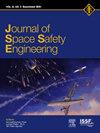Ionospheric TEC forecast using universal kriging and recurrent neural network over low-latitude during the X class solar flares occurred in the year 2024
IF 1.7
Q3 ENGINEERING, AEROSPACE
引用次数: 0
Abstract
In recent years, Statistical and machine learning models have been widely used for ionospheric total electron content (TEC) forecasting. In this research, we constructed a universal kriging (UK) statistical model and a recurrent neural network (RNN) machine learning model to forecast the TEC during six solar flares that happened in February and March 2024. Twelve months (from February 2023 to January 2024) of geomagnetic indices data like Planetary K Index (Kp), Planetary A Index (Ap), Disturbance Storm Time (DST) index and Solar indices data like Radio Flux at 10.7 cm (F10.7), Solar wind (Sw), and Sun Spot Number (SSN) along with GPS TEC values obtained from the IISC station, Bangalore (13.03° N and 77.57° E) were used for training and two months (February and March 2024) of data were used for testing the constructed models to forecast the TEC during the six solar flares (SF) occurred in the year 2024. The forecasted results showed that the UK model obtained root mean square error values (RMSE) of 6.76 during the X 3.38 SF, 5.58 during the X 2.25 SF, 4.85 during the X 1.9 SF, 7.0 during the X 6.3 SF, 12.29 and 6.74 during the X 1.1 SF when compared to the RNN model obtained RMSE values of 12.81, 14.34, 8.01, 9.39, 14.36 and 11.22 respectively. Analysis of TEC variations during February and March 2024 revealed diurnal patterns influenced by solar radiation, with high TEC values during the day and lesser at night. Comparison of UK and RNN predictions during the SF periods highlighted both models' superior ability to capture TEC variations, particularly at peaks and troughs. The linear regression statistical analysis showed high positive correlations (Pearson's r > 0.96) between actual and predicted TEC for both models, with UK demonstrating higher accuracy during intense solar flares (X6.3 and X3.38). Evaluation during the considered dates for the six SF periods indicated that the UK model provided better overall accuracy compared to RNN, though RNN showed competitive performance. The study underscores UK's potential for precise ionospheric TEC forecasting during solar disturbances, which is essential for space weather monitoring and satellite communication systems. However, the RNN model also performed well during high solar activity suggesting its suitability for capturing abrupt ionospheric changes. This study contributes insights into leveraging surrogate and machine learning models for ionospheric studies, demonstrating their effectiveness in predicting TEC variations under varying solar and geomagnetic conditions. The accuracy of prediction depends upon the size of the data set. This research will be useful to mitigate the positional accuracy errors in the navigation systems and also helpful for improved space communication during adverse solar activities.
利用通用克里格和递归神经网络对2024年X级太阳耀斑低纬度电离层TEC进行预报
近年来,统计模型和机器学习模型被广泛应用于电离层总电子含量(TEC)的预测。在这项研究中,我们构建了一个通用的kriging (UK)统计模型和一个递归神经网络(RNN)机器学习模型来预测2024年2月和3月发生的6次太阳耀斑期间的TEC。2023年2月至2024年1月12个月的行星K指数(Kp)、行星A指数(Ap)、扰动风暴时间(DST)指数等地磁指数数据和10.7 cm射电通量(F10.7)、太阳风(Sw)、太阳黑子数(SSN)等太阳指数数据,以及IISC站获得的GPS TEC值;利用班加罗尔(13.03°N和77.57°E)进行训练,并利用2024年2月和3月两个月的数据对所建立的模型进行了测试,以预测2024年6次太阳耀斑(SF)期间的TEC。结果表明,与RNN模型的RMSE分别为12.81、14.34、8.01、9.39、14.36和11.22相比,UK模型在X 3.38 SF、X 2.25 SF、X 1.9 SF、X 6.3 SF、X 1.1 SF的均方根误差(RMSE)分别为6.76、5.58、4.85、12.29和6.74。对2024年2月和3月的TEC变化分析揭示了受太阳辐射影响的日变化规律,即TEC值在白天较高,而在夜间较低。比较英国和RNN在SF期间的预测,突出了两种模式捕捉TEC变化的优越能力,特别是在峰值和低谷。线性回归统计分析显示高度正相关(Pearson’s r >;0.96),两个模型的实际和预测的TEC之间,英国在强烈的太阳耀斑期间显示更高的精度(X6.3和X3.38)。在六个SF周期的考虑日期期间的评估表明,与RNN相比,英国模型提供了更好的整体准确性,尽管RNN表现出了竞争力。这项研究强调了英国在太阳扰动期间精确预测电离层TEC的潜力,这对空间天气监测和卫星通信系统至关重要。然而,RNN模型在高太阳活动期间也表现良好,表明它适合捕捉电离层的突变。这项研究为利用代理模型和机器学习模型进行电离层研究提供了见解,证明了它们在预测不同太阳和地磁条件下TEC变化方面的有效性。预测的准确性取决于数据集的大小。该研究将有助于减轻导航系统的定位精度误差,并有助于改善太阳活动期间的空间通信。
本文章由计算机程序翻译,如有差异,请以英文原文为准。
求助全文
约1分钟内获得全文
求助全文
来源期刊

Journal of Space Safety Engineering
Engineering-Safety, Risk, Reliability and Quality
CiteScore
2.50
自引率
0.00%
发文量
80
 求助内容:
求助内容: 应助结果提醒方式:
应助结果提醒方式:


